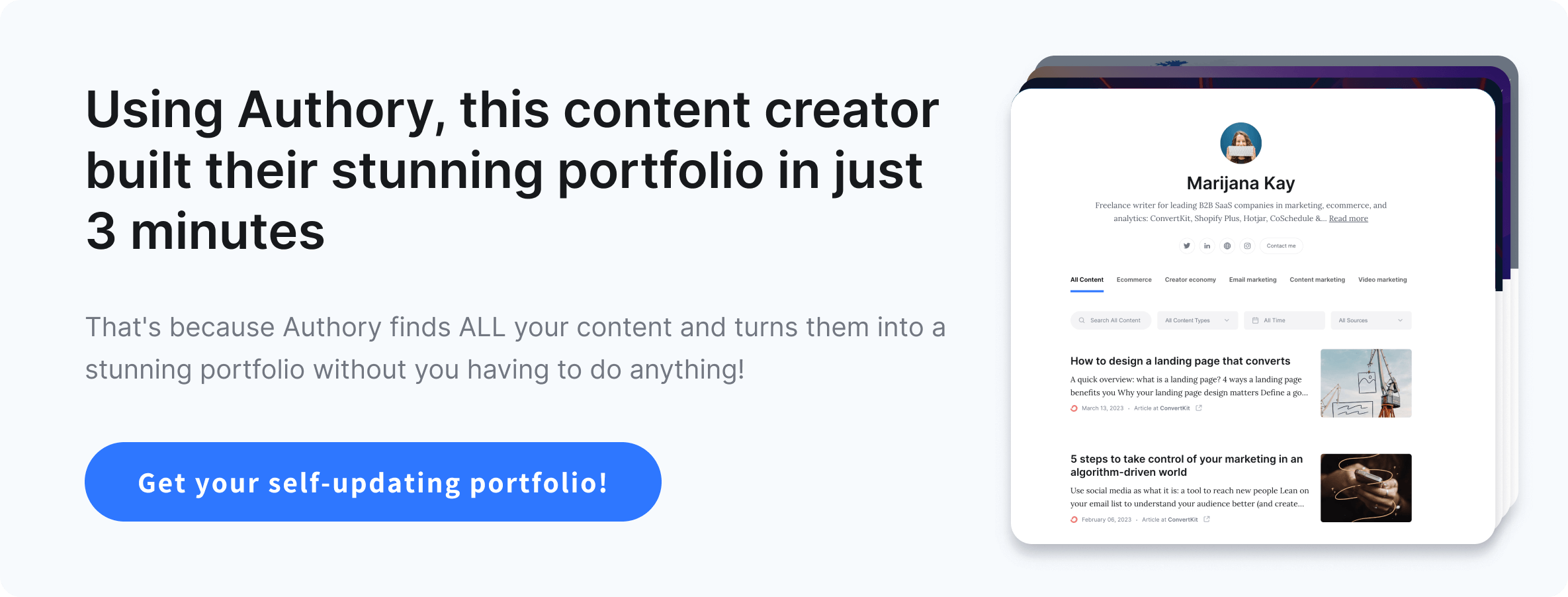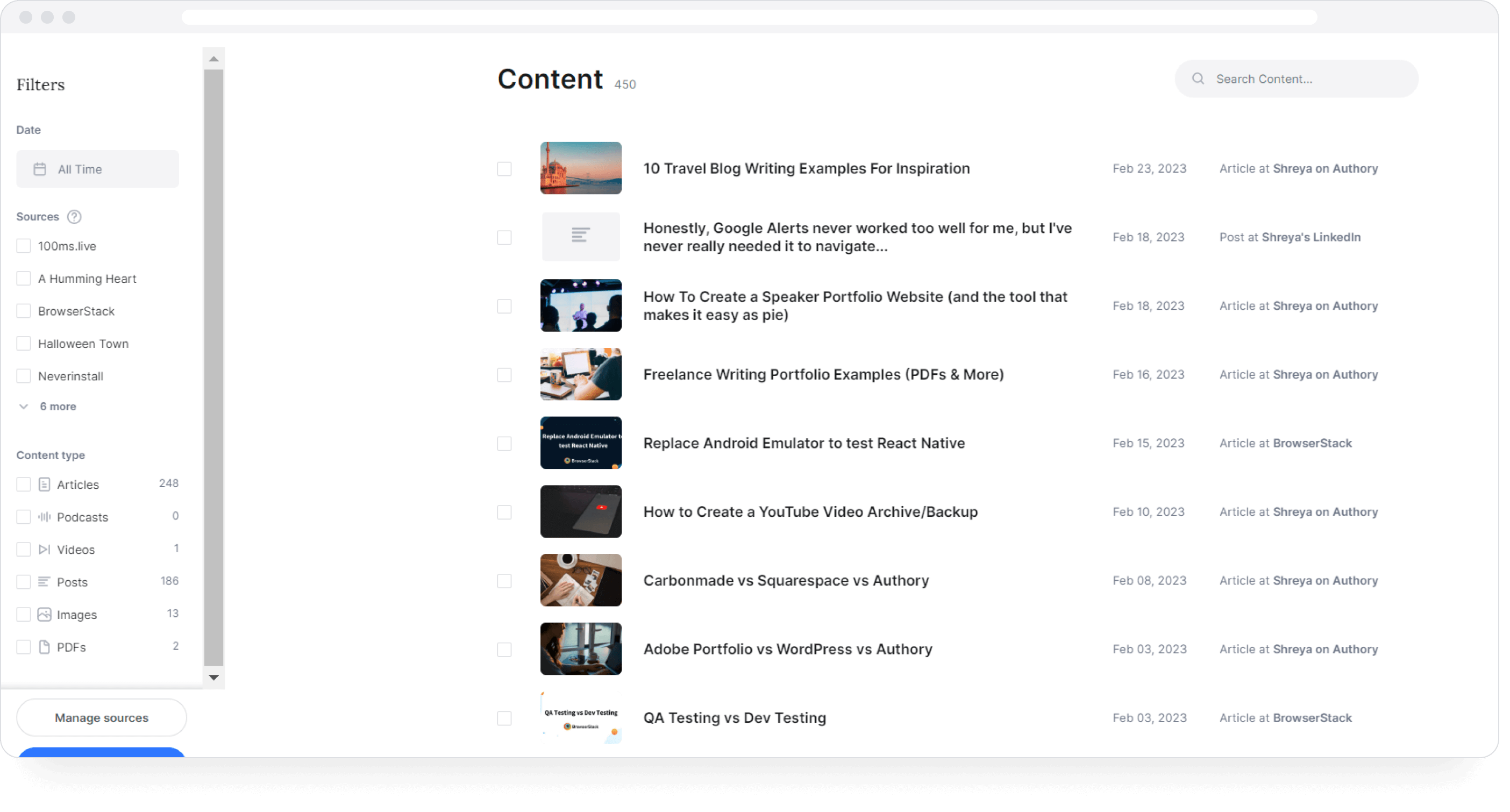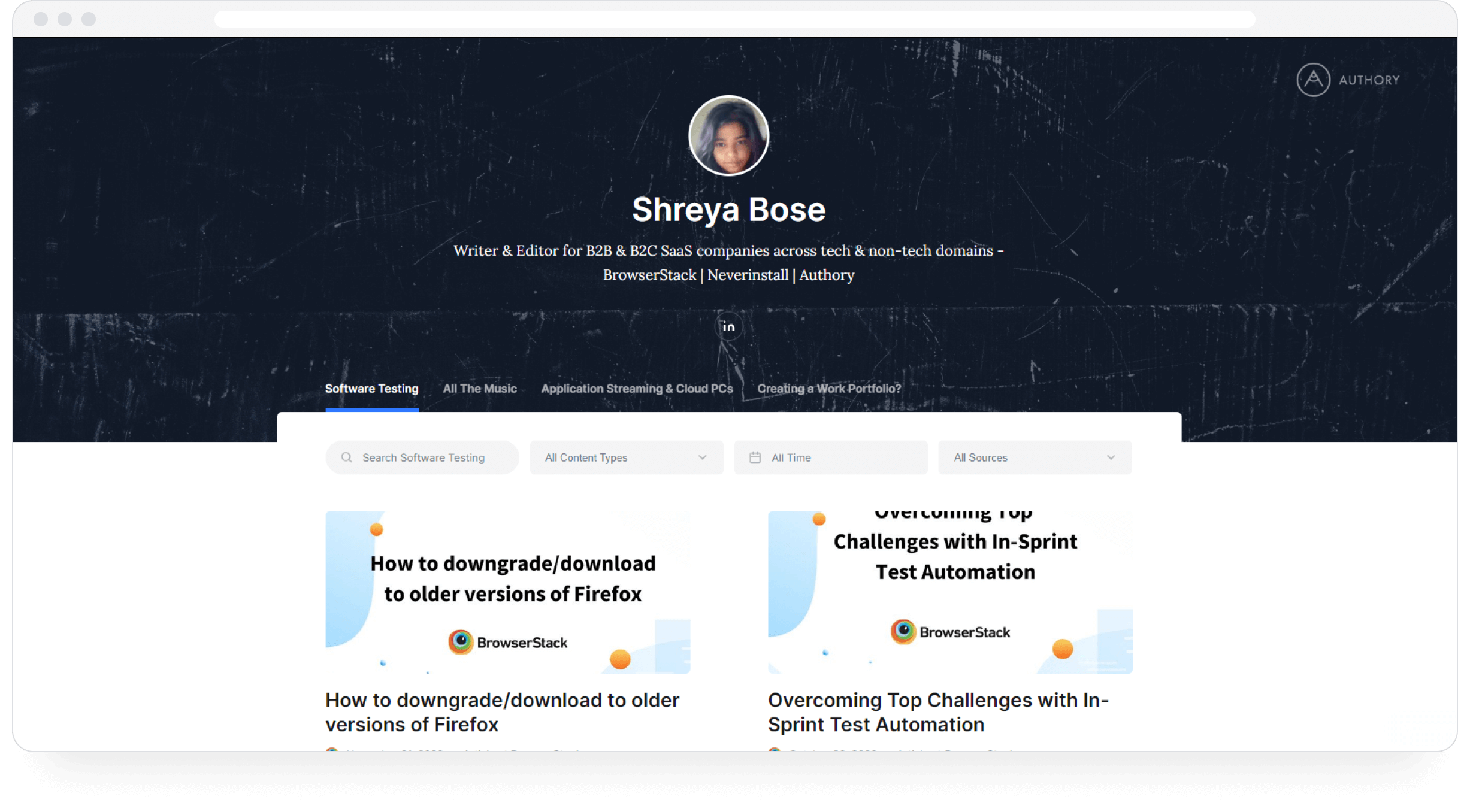So, what do you do? College professor? Content marketer? Painter? Photographer? Apple-picker? Wine taster? Full-time Netflix viewer? Oshiya (hired to push people into trains when they are too crowded)?
Yes, the last two are real jobs.
Why am I listing out professions? Because I want to make the point that, in most occupations, you need a professional portfolio. Unless you're planning to stay at a single job your entire life and never get fired, you need an up-to-date online portfolio that accurately and reliably summarizes your skills, personal goals, and proof of expertise.
The ideal portfolio is the textual/audio/video equivalent of an elevator pitch, meant to "wow" every hiring manager within a few minutes and make them think, "How do I hire this person right now?"
At Authory, we're all about helping you create the perfect portfolio. But this week, I decided to go back to basics and take about why portfolios are necessary in the first place.
This article may seem like a career beginner's cup of tea — if you're mid-career, you probably know from experience why portfolios are a must-have — but I'll also include some tips on how to create a portfolio desirable for recruiters/potential clients in 2023. So, why not have a look if you're doing some job-seeking this year?
• Major reasons why portfolios are important for any professional
• The essential aspects of the perfect portfolio
• Why you should try out Authory as a portfolio builder that automatically imports AND backs up all your published work.
Why are portfolios important?
Let's get the obvious answer out of the way. A portfolio literally introduces you to a potential employer. It’s a presentation of your qualifications, skills, experiences, attributes, and goals. It tells employers who you are and why you would make a valuable addition to their team/company.
However, there are a few other advantages a state-of-the-art electronic portfolio offers:
A permanent record of all your work
The right portfolio builder won't just make you copy-paste or upload links to your work. It will store all the work that you've published anywhere at any time. It serves as a permanent backup, ensuring that your work is never lost, even if the original publication link dies for any reason.
A searchable database for researching your own work
Let's say your new client asked you to write a blog on the most frequently used cybersecurity mechanisms in 2023. Let's also say you've already written about cybersecurity for half a decade. Wouldn't looking through your older articles be easier than starting research from scratch?
The right portfolio creates a searchable database of all your existing work so that you can find the right articles by typing in a keyword. No need to scroll through hundreds or thousands of pieces to find the one you're looking for.
A consistent record of your growth
Recruiters, prospective employers, and even you can scroll through your portfolio to get a fair idea of how you've grown your skills and output throughout your career. Let's say a hiring manager sees that your articles in 2022 are more thoroughly researched and have references from academic papers, as opposed to pieces in 2017 which mostly just had single-line quotes. This would likely make them feel that you'll depict similar intellectual growth and quantifiable productivity to the work you do for them.
It would also convey the impression that you are someone who is actively and consistently working to improve your knowledge base and writing style to keep up with the times.
Performing a similar exercise yourself is also a great way to identify which areas of your work have shown improvement and which aspects might need some work to get to 100%.
Instrumental in an application process
Portfolios don't just help you get new jobs or assignments. They are necessary when applying for scholarships, grants, residencies, and other forms of project or program funding — making them essential for job seekers and students alike.
Let's say you're applying for a grant to do independent research and write a book. You'll need to provide evidence of your skill and publication history, which is precisely what a portfolio does.
Essentials of the ideal portfolio
Include ALL your work
Common wisdom will tell you that you should only include your best work samples for your potential employers to peruse. My recent experience with job-searching, as well as the opinion of multiple hiring managers and interviewers, has convinced me that you need to have all or most of your work on your portfolio.
You don't just want to project the existence of your skill but also the consistent usage of that skill to generate significant output. It doesn't matter if you're putting out one great podcast every three months. Anyone hiring you would want to see that your excellence is not a one-hit-wonder, but rather... it is available on demand.
Ensure that it is easily navigable
Your portfolio is not your resume. It's not supposed to be a single page with one-liners. Instead, it explores your capabilities and accomplishments, so it'll be somewhat long. Consequently, it's important to ensure that you showcase your work in an organized and navigable format.
At the very least, your portfolio should be searchable. It should also have filters for isolating content types, publication sources (the site where your work is published), time/date/duration, and the like. Essentially, it should be a breeze for employers to find exactly what they are looking for.
Organization is our friend
If you're like me, you've been writing about everything from software testing to music to "how to create portfolios" to DaaS tools for a few years now. If so, finding a way to organize your content by topic, domain, or project is quite helpful. You really cannot expect people to painstakingly find their way and evaluate your work in a heap of unrelated content pieces.
For example, in my portfolio, I have articles under the following headers — Software testing, All The Music, Application Streaming & Cloud PCs, Creating a Work Portfolio?, Video Engineering & Streaming for Developers. Anyone can just click on one of these headers to explore the content assigned to them.
Tailor your portfolio to your client(s)
This only applies if you're looking to get a job with a specific client. Taking a previous example, let's say you're applying for a freelance writing role with a major cybersecurity firm. Obviously, they want to see your existing work within the industry, and thankfully, you've got plenty to show.
However, when sending your portfolio, try to ensure it primarily showcases only the relevant content. In other work, your portfolio should be immediately relatable to the client. If you're feeling adventurous and want to portray your versatility, retain work in somewhat connected industries.
For example, if I were pitching to a client in the software testing industry, I'd either showcase only the articles on software testing I have written so far. At most, I would also include articles on Cloud PCs and Video Engineering (since they are both technology-centric content), but I'd probably do away with my writings on music and portfolio creation.
With Authory, for example, you can group relevant content into collections and can add or remove these collections from your portfolio with a single click. Easy-peasy, no muss, no fuss!
Don't forget the basic details
In pursuit of a future-forward portfolio, quite a few of us might forget to include the obvious, basic details. I'm not kidding; we've seen actual users create portfolios with their contact information missing.
Include your full name, current position, social media links, and personal website link (if you have one). Ensure they have multiple avenues to contact you — email, social media, LinkedIn, and your phone number (only if you are comfortable sharing this). It's not necessary, but you can add a bit about your higher education if it’s directly related to your work.
Don't forget to add a well-written, succinct "About Me" section that sums up who you are, what you're capable of, and what you've achieved so far. Feel free to get creative with this bit.
Make it look good
Beauty indeed lies in the eyes of the beholder, but let's not pretend that conventional standards for what looks good don't exist. If they didn't, we wouldn't have Henry Cavill.
Pick a portfolio builder (like Authory) that lets you customize the aesthetic outlook and position of the elements of your portfolio. You don't need award-winning designs on portfolio templates (though they can certainly be nice to have) or complete customizability of every single aspect (unless you're a graphic designer/illustrator or you just like everything placed just so).
But you do need your portfolio to look professionally suitable, mostly understandable at one glance, and untouched by obvious visual faux pas such as clashing colors and oversized/undersized font.

A tool that creates your portfolio for you
We've already established that you can't just send work samples in a Google Drive folder and expect to be taken seriously. However, creating a portfolio that meets all the above criteria requires a tool equipped with features to fulfill said criteria from the get-go.
When switching from a full-time job to a freelance career, I realized that my projects needed to be in one place for simplified, organized viewing. Plus, many recruiters I spoke to were fairly baffled when I sent my work samples in a bare email (Yes, I was not on top of the game back then.)
So I went looking for a portfolio builder and ran through free trials of multiple tools — Squarespace, Journo Portfolio, Carbonmade, Wix... the works. Most of them were pretty useful, with exceptional features, but I chose Authory for a single feature.
Automatic importing of all your published, bylined content from anywhere on the internet.
As long as you enter the URL of the website, social media site, podcast platform, or video platform where your work is hosted, Authory extracts a copy (in the original format) of your bylined content and brings it to you in a single database. You can do this with multiple sites, which means you'll have all your content in one place forever.
That's another feature. All the content Authory automatically imports is also automatically saved. Consequently, you get a permanent and searchable database of ALL your work that you have complete access to.
This took the cake. It meant I wouldn't have to go looking for every specific article I'd ever written and submitted for publication.
Honestly, I didn't even remember that I'd written some of the earlier pieces, given that I have been writing for more than five years. Authory's system went back right to the beginning of my career and extracted perfect copies of pieces I had actually started my career with.
Within 48 hours, all my work was in one location. I could look through each piece, organize them into collections and put them on a finished portfolio within 3 minutes and a few clicks.

That's what my Authory database looks like. You'll see the list of articles (about 800 in my case) categorized by sources and content types (articles, LinkedIn posts, audio, video, PDFs, and images). Every content piece is permanently backed up, so I'll never lose anything, even if the original publication link and page die/is thrown into a redirect/disappears due to a domain lapse.
Here's what my portfolio looks like and what prospective employers see when I send them its link:

Recruiters can filter through content type, time (date or duration), and source (which website it's on). Content can also be categorized by topics via the Collections feature..
There's also an interesting Analytics feature, so you get real numbers on how many people have read/viewed, and engaged with your content over the past 30 days. It's pretty helpful to look at which topics do well with my audience and which ones need some more work.
If you're curious about how Authory work, you can start using it for free and join the ranks of a 6X Emmy winner David Pogue; Steven Levy, Editor at Large, WIRED; Brian Fung, a Technology Reporter at CNN, and numerous other stalwarts in every domain.
As a passing, here are a couple of customer testimonials that should give you a little food for thought:
I started using @Authory a couple of years ago after losing a bunch of samples when an old client took them down (whomp whomp). They automate the process for samples that have your byline, and I have a note on the calendar to go manually add new ghostwritten pieces once a month
— Kristen Hicks (@atxcopywriter) February 24, 2023
today i've looked at 100+ applications for freelance writing projects. tons say something like, "I'm qualified but can't share my ghostwritten samples."
— Jimmy Daly (@jimmy_daly) February 15, 2023
just use @Authory to do this. hiring managers need to see your best samples!
not an ad, just trying to make my life easier 😆
I just started using @Authory, it looks great, let's you organize your content super easily and can automatically import all your pieces from the web. It also keeps a backup of everything in case one of your articles is ever taken down. ~8-10 bucks a month 🙌
— Historian turned techie👩🎓👩💻 (@christina_haaa) February 9, 2023
Get Authory for free today and get started in just 3 minutes!





